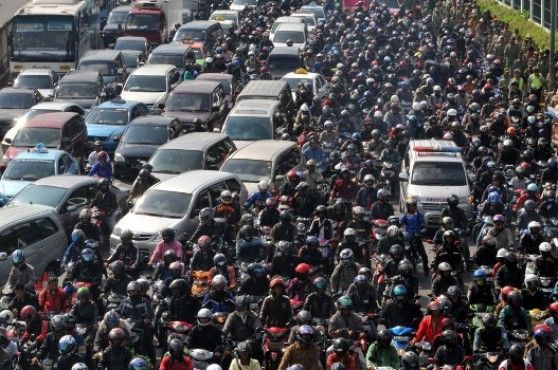Jakarta has some of the worst (arguably, the worst) traffic of any major city in the world. For many years, the Indonesian capital’s primary regulatio for fighting the endless macet was a 3-in-1 system that only allowed cars with three or more passengers to use the city’s major roads during morning and evening rush hour, a system many believe to be ineffective when it was repealed last year.
But according to the results of a new study co-authored by MIT and Harvard researchers, the 3-in-1 system was far more effective than almost anybody realized, and its revocation made traffic much worse than previously estimated.
The study, titled “Citywide effects of high-occupancy vehicle restrictions: Evidence from “three-in-one” in Jakarta” was published in today’s edition of the journal Science. It states “After the (3-in-1 policy was abruptly abandoned in April 2016, delays rose from 2.1 to 3.1 minutes per kilometer (min/km) in the morning peak and from 2.8 to 5.3 min/km in the evening peak. The lifting of the policy led to worse traffic throughout the city, even on roads that had never been restricted or at times when restrictions had never been in place.”
That equals a 46% increase in morning commute times and a whopping 87% increase in evening rush hour times. In fact, the authors note that average car speeds in the evening were just slightly above the average walking speed of humans.
To find those results, the study’s authors collected millions of data points from Google Maps and Android phones over a 4.5 week period starting just two days after the 3-in-1 system was revoked.
The study’s authors say the results of their research show that “HOV [high occupancy vehicle] policies can greatly improve traffic conditions”, making mandatory carpooling schemes a cheap and surprisingly effective way for governments to control congestion.
Plenty of Jakartans criticized the 3-in-1 system and doubted its effectiveness due to the “joki” phenomenon it created, in which drivers would pick up strangers waiting near the entrance to restricted roads and pay them a small fee for helping them to follow the traffic rule, in technicality if not spirit.
Many of those joki were women carrying babies, who were more likely to get picked up by drivers more often since they counted as two passengers. Ugly rumors that some of those babies were being rented out and drugged into docility seemed to be proven true after several people were arrested for their part in a cruel child-exploitation-for-profit ring, leading former Jakarta Governor Basuki “Ahok” Tjahaja Purnama to push for and ultimately revoke the 3-in-1 May 2017.
At the time, police had fought to keep the 3-in-1 as trial runs had shown that its removal had caused significant increases in traffic.
The study’s authors did admit that traffic conditions in Jakarta had improved somewhat several months after their research had ended, presumably due to drivers adapting to the new rules as well as the implementation of an odd-even license system on major roads.
Jakarta’s other major solutions to the ever worsening macet, including the mass rapid transit system (MRT) and electronic road pricing system (ERP), are still years away from completion (at least). Do you think the government should consider bringing back the 3-in-1 or implementing some other carpooling scheme in the meantime? Let us know what you think in the comments.




